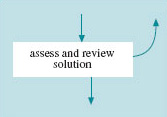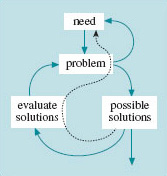4.6 Assess and review
Following our problem-solving map, we have reached the stage of 'assess and review solution', Figure 16.

If we've got everything right first time in the preceding stages, then the solution successfully meets the need, with no obvious nasty side effects, and we can pass directly to 'build prototype/demonstrator', pausing briefly for cheers and back-patting all round. On the other hand … this may be the time to recognise that the 'best solution' hasn't worked. This isn't necessarily as disastrous as it sounds; unless the solution was particularly simple, there are likely to be elements that have been found to be successful where others have not. This usually means that you are not entirely back to the drawing board, but will have to revise the bits that haven't worked and replace them with other suggestions that have been on ice from the 'possible designs' stage. If we were prolific with ideas then there may be an orderly queue of replacement solutions, such as alternative materials, configurations of components, substitute objects (in software design) or whatever. However, if there is no obvious alternative then we may end up having to reconsider the original need (Figure 17).

There's no shame in going back to the customer at this point and asking for clarification. It may even be that your solution worked according to the need they expressed, but some incidental aspect has proved unworkable and so the problem needs restating. Returning to the water problem and the need to transport water from the river – perhaps you have discovered that the flow of the river isn't enough to meet the needs of the village. In this case, there is no need to abandon the solution entirely, as it will still be possible to supply water from the river, but a supplementary water source must be identified and harnessed, and this will be the new problem. You put forward possible solutions … and so the cycle begins again.
